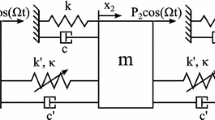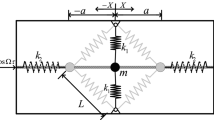Abstract
A computational scheme is presented in this paper to simulate dynamical behavior of multiple degrees of freedom (MDOF) systems with multiple bilinear springs. In the proposed scheme, a bilinear spring is modeled using by two parallel springs - a primary spring and a secondary spring. The primary spring is an ordinary linear spring having identical stiffness in tension and compression, and is active for tension and compression. The secondary spring, whose stiffness characterizes the bilinearity, is active only during compression. It is employed in connection with the Newmark integration method and the linear complementarity problem (LCP) formulation to obtain time-domain responses of dynamical systems with bilinear springs due to initial disturbances and harmonic excitations. The scheme described in this paper is effective in dealing with the sudden transition from tension to compression and vice versa simultaneously for all bilinear springs. Numerical results for bilinear oscillators with finite bilinearity ratios and impact oscillators with an infinite bilinearity ratio show that the proposed bilinear spring model is accurate, generic and valid for bilinearity ratios ranging from zero to infinity. Orderly and chaotic behavior of viscously damped 3-DOF system under harmonic excitation is studied for a wide range of excitation frequencies and bilinear ratios to demonstrate the effectiveness and applicability of the proposed model for MDOF bilinear systems.
Similar content being viewed by others
References
B. C. Wen, Y. N. Li, Y. M. Zhang and Z. W. Song, Vibration utilization engineering, Science Publisher, Beijing, China (2005).
J. A. Swanson and R. T. Leon, Stiffness modelling of bolted T-stub connection components, Journal of Structural Engineering, 127 (5) (2001) 498–505.
M. A. Davies and B. Balachandran, Impact dynamics in milling of thin-walled structures, Nonlinear Dynamics, 22 (2000) 375–392.
M. Wiercigroch, R. D. Neilson and M. A. Player, Material removal rate prediction for ultrasonic drilling of hard materials using an impact oscillator approach, Physics Letters A, 259 (1999) 91–96.
A. Rivola and P. R. White, Bispectral analysis of the bilinear oscillator with application to the detection of fatigue cracks, Journal of Sound and Vibration, 216 (5) (1998) 889–910.
J. A. Brandon and O. N. L. Abraham, Counter-intuitive quasi-periodic motion in the autonomous vibration of cracked Timoshenko beams, Journal of Sound and Vibration, 185 (3) (1995) 415–430.
T. G. Chondros, A. D. Dimarogonas and J. Yao, Vibration of a beam with a breathing crack, Journal of Sound and Vibration, 239 (1) ( 2001) 57–67.
A. Guzek, A. V. Dyskin, E. Pasternak and I. Shufrin, Asymptotic analysis of bilinear oscillators with preload, International Journal of Engineering Science, 106 (2016) 125–141.
Z. K. Peng, Z. Q. Lang and F. L. Chu, Numerical analysis of cracked beams using nonlinear output frequency response functions, Computers and Structures, 86 (2008) 1809–1818.
Z. K. Peng, Z. Q. Lang, S. A. Billings and Y. Lu, Analysis of bilinear oscillators under harmonic loading using nonlinear output frequency response functions, International Journal of Mechanical Sciences, 49 (11) (2007) 1213–1225.
Y. C. Chu and M. H. H. Shen, Analysis of forced bilinear oscillators and the application to cracked beam dynamics, AIAA Journal, 30 (10) (1992) 2512–2519.
T. L. Luo, J. Shih and S. Wu, A study of non-linear vibrational behavior of cracked structures by the finite element method, Journal of Marine Science and Technology, 13 (3) (2005) 176–183.
U. Andreaus and M. D. Angelis, Nonlinear dynamic response of a base-excited SDOF oscillator with double-side unilateral constraints, Nonlinear Dynamics, 84 (3) (2016) 1447–1467.
U. Andreaus, P. Baragatti, M. D. Angelis and S. Perno, A preliminary experimental study about two-sided impacting SDOF oscillator under harmonic excitation, Nonlinear Dynamics, 12 (6) (2017) 1–10.
U. Andreaus, P. Baragatti, M. D. Angelis and S. Perno, Shaking table tests and numerical investigation of twosided damping constraint for end-stop impact protection, Nonlinear Dynamics, 90 (2017) 2387–2421.
U. Andreaus and P. Casini, Dynamics of three-block assemblies with unilateral deformable contacts. Part 1: Contact modelling, Earthquake Engineering and Structural Dynamics, 28 (12) (1999) 1621–1636.
U. Andreaus and P. Casini, Dynamics of threeblock assemblies with unilateral deformable contacts. Part 2: Actual application, Earthquake Engineering and Structural Dynamics, 28 (12) (1999) 1637–1649.
C. Jung, K. D'Souza and B. I. Epureanu, Nonlinear Amplitude approximation for Bilinear systems, Journal of Sound and Vibration, 333 (2014) 2909–2919.
Y. L. Ma, S. D. Yu and D. L. Wang, Nonlinear vibrational behavior of multi-body dynamical systems with bidirectional piecewise linear spring constraints, Journal of Vibration and Control, 22 (7) (2014) 1808–1819.
D. S. Sha, H. Sun, Z. Zhang and F. Yin, A variational inequality principle in solid mechanics and application in physically non-linear problems, Communications in Applied Numerical Methods, 6 (2010) 35–45.
M. S. Bazaraa and C. M. Shetty, Nonlinear programming theory and algorithms, Wiley (1979).
Author information
Authors and Affiliations
Corresponding author
Additional information
Recommended by Associate Editor Jin Woo Lee
Yali Ma obtained her Bachelor’s degree, Master’s degree and Ph.D. in Mechanical Engineering from Dalian University of Technology. She is a Professor of Mechanical Engineering at Dalian University of Technology, a member of China Mechanical Design Institute Committee. She was a visiting researcher at the Department of informatics at King's College London, UK in 2006. Her research interests include behaviors analysis and modeling, digital design, optimization design and innovation design of mechanical systems.
Shudong Yu obtained his Bachelor’s degree in Mechanical Engineering from Jiangxi University of Technology in 1982, Master’s degree in Mechanics from Northeastern University in 1984, Ph.D. in Mechanical Engineering from the University of Toronto in 1995. He is a Professor of Mechanical Engineering at Ryerson University, Toronto, Canada. His research interests include nuclear fuel design and modeling, non-linear vibration, friction, contact, multi-body dynamics, and flow-induced vibration.
Delun Wang obtained his Bachelor’s degree from Jiangxi University of Technology in 1982, Master’s degree and Ph.D. in Mechanical Engineering from Dalian University of Technology. He is a Professor of Mechanical Engineering at Dalian University of Technology, a Co-chair of Consultancy Committee of Teaching for Basic Program of Mechanical Engineering, Ministry of Education of China, a Chair of Teaching and Researching Committee of Theory of Mechanisms and Machine of China. He was an Associate Editor of Journal of Mechanisms and Robotics, ASME, 2009–2013. His research interests include kinematic geometry of mechanisms, methodology of machine design, accuracy design of machinery.
Rights and permissions
About this article
Cite this article
Ma, Y., Yu, S. & Wang, D. Modeling dynamic behavior of MDOF systems with multiple bilinear springs. J Mech Sci Technol 32, 4057–4069 (2018). https://doi.org/10.1007/s12206-018-0805-5
Received:
Revised:
Accepted:
Published:
Issue Date:
DOI: https://doi.org/10.1007/s12206-018-0805-5




